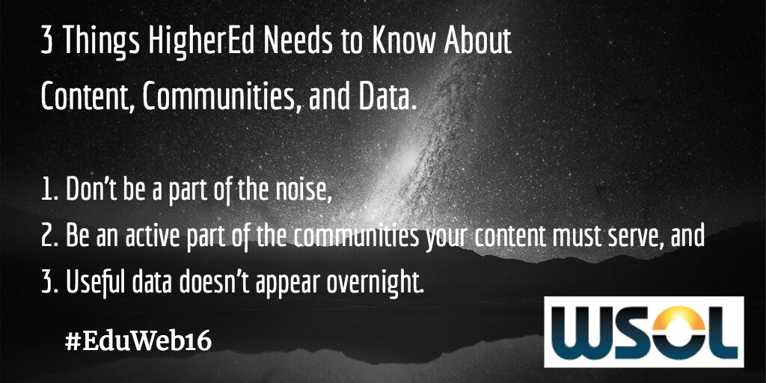3 Things HigherEd Should Know About Content, Communities, & Data
Doug Miller#Digital Marketing, #Inbound Marketing, #Community

We offer three lessons that can help HigherEd content marketers know how to get the right content in front of the right people at the right time.
The topic of "How to identify micro-communities and use historical data to plan successful content marketing" has been selected for this year’s Using Data and Analytics track at #EduWeb16. Join me in Denver in August for the full presentation and some useful tools. In the interim, here's a brief preview and some related tips:
Higher Education has some really big challenges to overcome. Aside from being charged with preparing citizens of many ages to be successful in life and future work (no small task), organizations have to do this knowing that any content they create is quickly awash in an ocean of attention-grabbing distractions and diversions. What must they do?
I’ve had the pleasure of having worked inside of HigherEd as both faculty and staff, where I got to experience first-hand the challenges of breaking through the noise. During that time, I learned three things about content, communities, and data that have proven indispensable in getting the right content in front of the right people at the right time:
- Don’t be a part of the noise.
- Be an active part of the communities your content must serve.
- Useful data doesn’t appear overnight.
Let's look at each of these lessons in more detail:
Don’t be a part of the noise
It can be very tempting to rely on a scatter-gun approach when you know you have a message you need to get to a certain number of people in a certain amount of time. Hitting a broad email list, paying for broad search keywords, and canvassing all media (paid, earned, and owned) with a similar message can all seem justified considering what’s at stake. After all, your brand message is like a bunch of tiny turtles emerging from the sand, desperate to survive a treacherous stretch of beach; the more you send, the more that might make it to the end, right? It works for Mother Nature, why not for our content?
The problem is, Mother Nature we are not. Nature has systems of checks and balances. Those turtles on that beach are a great example of balance - too many could mean disaster in some other part of the ecosystem and too few a negative all its own. As we approach our own content, it can be tempting to think that “every turtle must make it to the sea.” The problem is, every other content creator attempting to capture the attention of your audience feels the same way. The common temptation is simply to turn up the volume and frequency. That can get your content quickly classified as noise in the broader ecosystem of things vying for attention, and the natural defense against it is for it to be ignored.

If you want your content to be successful, you need to make sure it doesn’t get classified as “noise.” To do that, you have to be able to identify and define what noise is to your audience, and what its opposite, signal, is too. You can’t do that without listening first yourself. You must take a depth sounding of your audience and listen to the returning pings. What equals noise to them? Where do they find their trusted signals? There are ways to glean this from data, but even that cannot be done without the second thing I’ve learned.
Be an active part of the communities you serve
To be successful, your content must serve a community. It must be considered signal in that community and not noise. It is impossible to create content that serves a community without first being an active participant in the communities your content must serve. In HigherEd, a problem has emerged over time that makes this process more difficult now than ever. What was once a reliable chunk of the population any HigherEd organization serves has now fragmented into a seemingly insurmountable number of variables.
The profile of a “traditional student” is harder and harder to pin down because the citizens being served by HigherEd are coming from broader sets of experience and contexts than ever before. That makes it more difficult as well to determine with any certainty, from the point of view of the communities your content must serve, what will be signal and what will be noise.
Organizations need to define and connect with their community members, but to do that, they first need to properly identify their relevant micro-communities, a process that can seem like a Herculean task. Luckily, there is leverage in the shape of data that can help you both define these micro-communities and identify what they consider signal and what they consider noise.
Unfortunately, many organizations approach content and community with a conflict of agenda. They have demands put upon them to provide “return on investment,” and, as a result, the focus during content planning becomes more about “what we want to sell” and less about “what each community needs.”
Being an active part of the communities your content must be designed to serve can provide streams of data that will add definition to your understanding of those communities and what they value. It becomes the ounce of prevention worth a pound of cure for content that simply gets ignored. Being aware of the micro-communities your content must be designed to serve requires an understanding the third and final lesson I have learned.
Useful data doesn’t appear overnight
The old ways of measuring community are not sufficient. Where once it was possible to group large swaths of the population according to age, geography, ethnicity, religious or political persuasion, gender, or affluence and infer what content might be deemed signal over noise, modern times find more need for nuance. Micro-communities can quickly coalesce and disperse around ideas, interests, events and identities. To determine and properly target the communities you want your content to serve, you need intelligence.
That intelligence may already be there, locked away inside performance data about content already out there. The deeper that history goes, the more likely you are to be able to glean from it the information you need about the communities your content must serve. It may be siloed away from another data point that, when the two are looked at together, might unlock useful perspective.
This useful data, however, takes time to generate, and the sensors that collect that data must already be in place if it is to enable you to predict more about your communities and the content they would consider to be signal and not noise. If this is not the case, and those sensors are not in place, the data doesn’t manifest from thin air. Patience and a sense of the value of the long view can be the best defense against a return to the temptation to spend resources creating content that will simply be ignored because it is simply noise to its community.
Successful Inbound Marketing Values Community
We are now truly deep into the age of the attention economy. Nowhere is that more evident than in the challenges faced by organizations who are vying desperately for the attention of potential customers or supporters. Organizations who need to connect with their community members and provide valuable content would do well to remember the three things HigherEd needs to know about content, communities, and data; all of which can be summed up in the imperative to:
“Ask not what your content can do for you, but what you - through your content - can do for your community.”
Related Posts

Why You Need an SEO Content Audit in your Migration Plan
Diagram's Allison Casey spills all her insider SEO tips on migrating your content the right way.

What is Umbraco CMS?
Migrating your content management system? Why not consider Umbraco? Learn about this .NET CMS, pricing and why it's the right choice for your organization.
Results Matter.
We design creative digital solutions that grow your business, strengthen your brand and engage your audience. Our team blends creativity with insights, analytics and technology to deliver beauty, function, accessibility and most of all, ROI. Do you have a project you want to discuss?
Like what you read?
Subscribe to our blog "Diagram Views" for the latest trends in web design, inbound marketing and mobile strategy.

